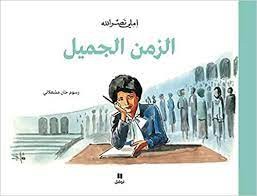
Product Description
Description رحلة جديدة تأخذنا فيها املي نصرالله إلى لبنان الخمسينات. بأسلوبها الدافئ والحنون، ونصّها الغنيّ من دون بهرجة والكثيف من دون استعراض، تجول بنا في عوالمها الخاصة ولا نشعر بالغربة. تغدق علينا الأديبة التي كانت لا تزال في جلد الصحافية تجربتها في «الزمن الجميل»، تذكّرنا بأسماء نسيناها، تقدّم لنا أخرى لا نعرفها، من خلال وجوه قابلتها وحاورتها. هنّ نساء في الأغلب. نساء مناضلات، كلّ على طريقتها، في المجال العام أو الخاص، جهارًا أو صمتًا: من إدفيك جريديني شيبوب إلى الملكة فاطمة السنوسي، وسيدة الرائدات إبتهاج قدورة، ومغنية الأوبرا اللبنانية الأولى سامية الحاج، حتى البصّارة فاطمة، ومارتا، الطالبة الثمانينية في الجامعة الأميركية. نساء نصرالله لم يكنّ من حبر فقط. اتّخذن أشكالًا أيضًا على يد الرّسام جان مشعلاني، الذي دأب على مرافقة الصحافية الشغوفة، وتزيين مقالاتها على صفحات مجلّة الصّياد على مدى سنوات. رحلة ثريّة روحيًّا وبصريًّا، يتقاطع فيها الشخصي مع العام ليتجاوز السّرد الصحفي والأدبي حدود المقابلة إلى رحاب الوطن والمجتمع. Biographical note أديبة لبنانية رائدة، عملت في الصحافة، ثمّ غلب عليها الأدب فانصرفت إلى كتابة الرواية والقصّة والسيرة وأدب الفتيان والأطفال. تُرجِم الكثير من كتبها إلى الإنكليزية والألمانية والدانمركية والفنلندية والتايلندية. حصلت على جوائز عديدة منها جائزة الشّاعر سعيد عقل في لبنان وجائزة مجلّة فيروز، وجائزة جبران خليل جبران من رابطة التراث العربيّ في أستراليا، كما نالت عام 2018 وسام الأرز اللبناني عن رتبة كومندور تقديرًا لعطاءاتها الأدبية.-In a new journey, Emily Nasrallah takes us to Lebanon in the 1950s. With her warm and affectionate style, and her rich and substantial prose without exaggeration, she wanders with us in her own world, and we don't feel estranged. The author, who was still in the skin of a journalist, generously shares her experience in ""the beautiful era"" as we call the 50's/60's in the Arab World, reminding us of names we had forgotten and introducing us to others we didn't know, through faces she met and interviewed. Most of them are women, fighters each in her own way, in the public or private sphere, outspokenly or in silence: from Edwige Ghiradini Sheboub to Queen Fatima Al-Senussi, from the leader Ibtihaj Qaddoura to the first Lebanese opera singer Samia Al-Hajj, and even Fatima the fortune-teller, and Martha, the octogenarian student at the American University of Beirut. Nasrallah's women were not just ink on paper. They also took shape in the hands of the artist Jean Michelani, who accompanied the enthusiastic journalist and adorned her articles on the pages of the local Lebanese magazine Al-Sayyad for years. It is a spiritually and visually rich journey, where the personal intersects with the public, transcending the boundaries of journalistic and literary narration to the realm of homeland and society.

